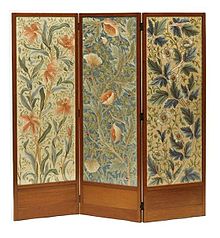Art needleworkwas a type of surfaceembroiderypopular in the later nineteenth century under the influence of thePre-Raphaelitesand theArts and Crafts Movement.

Artist and designerWilliam Morrisis credited with the resurrection of the techniques offreehand surface embroiderybased onEnglishembroidery styles of theMiddle Agesthrough the eighteenth century, developing the retro-style which would be termedart needlework.Art needlework emphasized delicate shading insatin stitchwithsilkthread accompanied by a number of novelty stitches, in sharp contrast with thecounted-threadtechnique of the brightly coloredBerlin wool workneedlepointcraze of the mid-nineteenth century.

In embroidery as in other crafts, Morris was anxious to encourage self-expression via handcrafts. His shopMorris & Co.sold both finished custom embroideries and kits in the new style, along with vegetabledyedsilksin which to work them. Art needlework was considered an appropriate style for decoratingartistic dress.
The Royal School of Art Needlework (nowRoyal School of Needlework) was founded as a charity in 1872 under the patronage ofPrincess Helenato provide apprenticeships in the new/old style. Morris's daughterMay,an accomplished needlewoman and designer in her own right, was active in the School from its inception.
The Leek Embroidery Society and the Leek School of Art Embroidery, both founded by embroideressElizabeth Wardle,were established in 1879 and around 1881, respectively.[2][3]
Art needlework was introduced toAmericaat the 1876Centennial ExpositioninPhiladelphia.
Notes
edit- ^"Artichoke" hanging designed by William Morris for Ada Phoebe Godman in 1877 and subsequently available from Morris and Company. Linda Parry,William Morris Textiles,New York, Viking Press, 1983, p. 20-21
- ^William Morris (2014) [1984].Norman Kelvin(ed.).The Collected Letters of William Morris, Volume I: 1848-1880.Princeton University Press. p. 262.ISBN9780719067006.
- ^Linda Cluckie (2008).The Rise and Fall of Art Needlework: Its Socio-economic and Cultural Aspects.Arena books. pp. 14, 95–97.ISBN9780955605574.
References
edit- Katharine A. Lochnan; Douglas E. Schoenherr; Carole Silver, eds. (1996).The Earthly Paradise: Arts and Crafts by William Morris and His Circle from Canadian Collections.Key Porter Books.ISBN1-55013-450-7.
- Todd, Pamela (2001).Pre-Raphaelites at Home.Watson-Guptill Publications.ISBN0-8230-4285-5.